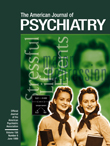Eating Attitudes Among Black South Africans
To the Editor: Regarding the study by Daniel le Grange, Ph.D., and colleagues (1), it is pertinent to share my experience of the emerging phenomenon of eating disorders in black South Africans. While the existence of eating disorders in white South Africans is well established (2, 3), as recently as 1994 published literature on eating disorders in South Africa (4) commented on the absence of black sufferers. In 1995, the first published cases of eating disorders in black female South Africans appeared (5). I was involved in the assessment and treatment of two of the three described patient cases. To date, the number of cases I have been involved with has increased to nine. Of specific interest has been the absence of any unique features designating the sufferer as black. This suggests that within the urban setting, there is a homogenization of eating-related psychopathology across racial groups. Considering this observation within the context of cultural issues, it appears that the culture of milieu is of more relevance than that of race. Such an understanding is inferred in a recent North American study (6). Of note, however, has been the tendency of black South African sufferers to present with bulimic symptoms as part of their illnesses. These observations are similar to those of Dolan (7) in a review of cross-cultural aspects of eating disorders. A number of case reports of eating disorders in black Africans appeared in the literature in the 1980s (8–10), and it is not clear to what extent the occurrence of such conditions has changed in African countries outside South Africa. Our own preliminary research into abnormal eating attitudes among adolescent female South Africans within a private school setting (N=213) revealed that 20.7% of white respondents and 37.5% of black respondents scored above the cutoff score, denoting eating attitudes as abnormal, on the 26-item version of the Eating Attitudes Test (11). Preliminary analysis of more recent research into abnormal eating attitudes in government schools (N=1,353) revealed that 18.6% of black and white adolescents scored above the cutoff score (12). Together with the findings of le Grange et al., it is clear that within the broader South African community, eating attitudes exist that place a significant proportion of adolescents and young adults of all race groups at risk for the development of eating disorders. The conceptualization of eating disorders as racially bound within an urban setting in South Africa needs to be dispelled given that these conditions pose a potential public health risk for black South Africans.
1. le Grange D, Telch CF, Tibbs J: Eating attitudes and behaviors in 1,435 South African Caucasian and non-Caucasian colllege students. Am J Psychiatry 1998; 155:250–254Abstract, Google Scholar
2. Beumont PJV, George GCW, Smart DE: “Dieters” and “vomiters and purgers” in anorexia nervosa. Psychol Med 1976; 6:617–622Crossref, Medline, Google Scholar
3. Norris DL: Clinical diagnostic criteria for primary anorexia nervosa, an analysis of 54 consecutive admissions. S Afr Med J 1979; 56:987–993Medline, Google Scholar
4. Nash ES, Colborn AL: Outcome of hospitalised anorexics and bulimics in Cape Town, 1979–1989. S Afr Med J 1994; 84:74–79Medline, Google Scholar
5. Szabo CP, Berk M, Tlou E, Allwood CW: Eating disorders in black South African females, a series of cases. S Afr Med J 1995; 85:588–590Google Scholar
6. le Grange D, Telch CF, Agras SW: Eating and general psychopathology in a sample of Caucasian and ethnic minority subjects. Int J Eat Disord 1997; 21:285–293Crossref, Medline, Google Scholar
7. Dolan B: Cross-cultural aspects of anorexia nervosa and bulimia: a review. Int J Eat Disord 1991; 10:67–78Crossref, Google Scholar
8. Nwaefuna A: Anorexia nervosa in a developing country. Br J Psychiatry 1981; 138:270–271Crossref, Medline, Google Scholar
9. Buchan T, Gregory LD: Anorexia nervosa in a black Zimbabwean. Br J Psychiatry 1984; 145:326–330Crossref, Medline, Google Scholar
10. Famuyiwa OO: Anorexia nervosa in two Nigerians. Acta Psychiatr Scand 1988; 78:550–554Crossref, Medline, Google Scholar
11. Szabo CP, Hollands C: Abnormal eating attitudes in secondary-school girls in South Africa, a preliminary study. S Afr Med J 1997; 87:524–530Medline, Google Scholar
12. Szabo CP, Allwood CW: Eating disorders in black, urban, female, adolescent South Africans: a future public health problem? (abstract). S Afr Med J 1996; 86:1600Medline, Google Scholar



